Jewish Historical Fiction for Older Readers: The Holocaust (Page 4) |
If you wish to purchase any of these books, click on either the title or the book cover to be directed to Amazon.com. As a warning, I have put up pictures of the book covers to give you somewhat an idea of the style of each book (I know, I know. "Don't judge a book by its cover") so the pages may load slowly, depending on the speed of your internet connection.
If this page came up without frames, Click here to see the complete website
For biographies of individuals associated with the Holocaust (Anne Frank,
Simon Wiesenthal, etc.), go to the
Biographies
For Nonfiction Holocaust books, go to the
Holocaust History Page
For Holocaust books for younger readers, go to the Children's History Page
Other Pages of Interest:
Holocaust Historical Fiction Books For Middle School and Young Adult Readers ...
(Page 1)
(Page 2)
(Page 3)
(Page 4)
(Page 5)
(Page 6)
Holocaust History Books For Middle School and Young Adult Readers (Nonfiction)...
(Page 1)
(Page 2)
(Page 3)
(Page 4)
(Page 5)
(Page 6)
Middle School and YA Books ...
Bar Mitzvah Books |
Jewish Fiction |
Historical Fiction |
Torah Study |
Prayer and Jewish Life Books |
Jewish Holidays |
Jewish Biographies |
Jewish History Books |
Holocaust Books for Teens |
Israel Books
Jewish Historical Fiction for Middle School and YA Readers...
Biblical Era |
Middle Ages, Renaissance, and the Spanish Inquisition |
Immigration & The American Experience |
European History |
Holocaust
(Page 1)
(Page 2)
(Page 3)
(Page 4)
(Page 5)
(Page 6) |
Israel
Jewish History Books for Middle School and Young Adult Readers ...
General Jewish History & Nonfiction |
Biblical Era |
European History (Excluding the Holocaust) |
Immigration & The American Experience |
Holocaust |
Israel
Easy Reader and Picture Books ...
Jewish Children's Books (General) |
Jewish Board Books |
Biblical Stories for Children |
Jewish Holiday Books |
Jewish Family Cookbooks |
Folktales and Talmudic Stories for Children |
Jewish Life Books (Mitzvot, Keeping Kosher, etc.) |
Jewish Life Cycle Books |
Family Haggadahs |
Children's Prayerbooks |
Introductory Hebrew Books |
Jewish History and Historical Fiction Picture Books |
Israel Books
And More ...
Jewish Books for Children |
Bar Mitzvah Books |
Jewish Parenting Books |
Hanukkah Books |
Jewish Music for Children |
Jewish Videos |
Jewish Toys and Gifts |
Jewish Gift Baskets and Gourmet Food |
Jewish Jewelry |
Amazon.com Coupons, Promotions, and Sales
For biographies of individuals associated with the Holocaust (Anne Frank,
Simon Wiesenthal, etc.), go to the
Biographies
For Nonfiction Holocaust books, go to the
Holocaust History Page
For Holocaust books for younger readers, go to the Children's History Page
Other Pages of Interest:
Holocaust Historical Fiction Books For Middle School and Young Adult Readers ...
(Page 1)
(Page 2)
(Page 3)
(Page 4)
(Page 5)
(Page 6)
Holocaust History Books For Middle School and Young Adult Readers (Nonfiction)...
(Page 1)
(Page 2)
(Page 3)
(Page 4)
(Page 5)
(Page 6)
Middle School and YA Books ...
Bar Mitzvah Books |
Jewish Fiction |
Historical Fiction |
Torah Study |
Prayer and Jewish Life Books |
Jewish Holidays |
Jewish Biographies |
Jewish History Books |
Holocaust Books for Teens |
Israel Books
Jewish Historical Fiction for Middle School and YA Readers...
Biblical Era |
Middle Ages, Renaissance, and the Spanish Inquisition |
Immigration & The American Experience |
European History |
Holocaust
(Page 1)
(Page 2)
(Page 3)
(Page 4)
(Page 5)
(Page 6) |
Israel
Jewish History Books for Middle School and Young Adult Readers ...
General Jewish History & Nonfiction |
Biblical Era |
European History (Excluding the Holocaust) |
Immigration & The American Experience |
Holocaust |
Israel
Easy Reader and Picture Books ...
Jewish Children's Books (General) |
Jewish Board Books |
Biblical Stories for Children |
Jewish Holiday Books |
Jewish Family Cookbooks |
Folktales and Talmudic Stories for Children |
Jewish Life Books (Mitzvot, Keeping Kosher, etc.) |
Jewish Life Cycle Books |
Family Haggadahs |
Children's Prayerbooks |
Introductory Hebrew Books |
Jewish History and Historical Fiction Picture Books |
Israel Books
And More ...
Jewish Books for Children |
Bar Mitzvah Books |
Jewish Parenting Books |
Hanukkah Books |
Jewish Music for Children |
Jewish Videos |
Jewish Toys and Gifts |
Jewish Gift Baskets and Gourmet Food |
Jewish Jewelry |
Amazon.com Coupons, Promotions, and Sales
Other Pages of Interest:
Holocaust Historical Fiction Books For Middle School and Young Adult Readers ...
(Page 1)
(Page 2)
(Page 3)
(Page 4)
(Page 5)
(Page 6)
Holocaust History Books For Middle School and Young Adult Readers (Nonfiction)...
(Page 1)
(Page 2)
(Page 3)
(Page 4)
(Page 5)
(Page 6)
Middle School and YA Books ...
Bar Mitzvah Books |
Jewish Fiction |
Historical Fiction |
Torah Study |
Prayer and Jewish Life Books |
Jewish Holidays |
Jewish Biographies |
Jewish History Books |
Holocaust Books for Teens |
Israel Books
Jewish Historical Fiction for Middle School and YA Readers...
Biblical Era |
Middle Ages, Renaissance, and the Spanish Inquisition |
Immigration & The American Experience |
European History |
Holocaust
(Page 1)
(Page 2)
(Page 3)
(Page 4)
(Page 5)
(Page 6) |
Israel
Jewish History Books for Middle School and Young Adult Readers ...
General Jewish History & Nonfiction |
Biblical Era |
European History (Excluding the Holocaust) |
Immigration & The American Experience |
Holocaust |
Israel
Easy Reader and Picture Books ...
Jewish Children's Books (General) |
Jewish Board Books |
Biblical Stories for Children |
Jewish Holiday Books |
Jewish Family Cookbooks |
Folktales and Talmudic Stories for Children |
Jewish Life Books (Mitzvot, Keeping Kosher, etc.) |
Jewish Life Cycle Books |
Family Haggadahs |
Children's Prayerbooks |
Introductory Hebrew Books |
Jewish History and Historical Fiction Picture Books |
Israel Books
And More ...
Jewish Books for Children |
Bar Mitzvah Books |
Jewish Parenting Books |
Hanukkah Books |
Jewish Music for Children |
Jewish Videos |
Jewish Toys and Gifts |
Jewish Gift Baskets and Gourmet Food |
Jewish Jewelry |
Amazon.com Coupons, Promotions, and Sales
Holocaust History Books For Middle School and Young Adult Readers (Nonfiction)... (Page 1) (Page 2) (Page 3) (Page 4) (Page 5) (Page 6)
Middle School and YA Books ... Bar Mitzvah Books | Jewish Fiction | Historical Fiction | Torah Study | Prayer and Jewish Life Books | Jewish Holidays | Jewish Biographies | Jewish History Books | Holocaust Books for Teens | Israel Books
Jewish Historical Fiction for Middle School and YA Readers... Biblical Era | Middle Ages, Renaissance, and the Spanish Inquisition | Immigration & The American Experience | European History | Holocaust (Page 1) (Page 2) (Page 3) (Page 4) (Page 5) (Page 6) | Israel
Jewish History Books for Middle School and Young Adult Readers ... General Jewish History & Nonfiction | Biblical Era | European History (Excluding the Holocaust) | Immigration & The American Experience | Holocaust | Israel
Easy Reader and Picture Books ... Jewish Children's Books (General) | Jewish Board Books | Biblical Stories for Children | Jewish Holiday Books | Jewish Family Cookbooks | Folktales and Talmudic Stories for Children | Jewish Life Books (Mitzvot, Keeping Kosher, etc.) | Jewish Life Cycle Books | Family Haggadahs | Children's Prayerbooks | Introductory Hebrew Books | Jewish History and Historical Fiction Picture Books | Israel Books
And More ... Jewish Books for Children | Bar Mitzvah Books | Jewish Parenting Books | Hanukkah Books | Jewish Music for Children | Jewish Videos | Jewish Toys and Gifts | Jewish Gift Baskets and Gourmet Food | Jewish Jewelry | Amazon.com Coupons, Promotions, and Sales
 The Night Crossing By Karen Ackerman |
This simple docu-novel about a Jewish child escaping
from the Nazis in 1938 introduces the Holocaust to young
readers. On the first page, Clara overhears her parents
whispering that they must leave their home in Innsbruck,
Austria, "before it is too late." Then we see why: Clara and
her older sister are chased home by a group of screaming
anti-Semitic kids, including her former best friend. All
around them, Jewish businesses are being vandalized, their
owners sent to camps, their homes burglarized. Clara's
parents sell their precious belongings and cut off their
yellow stars, and the family steals away in the night. Of
course, they are nearly caught, but they bribe and trick
and make it past the border guards and walk over the
mountains to Switzerland. There's little of the immediacy
and depth here of the best personal accounts for middle
readers, such as Ida Vos' Hide and Seek (1991)
or Isabella Leitner's Big Lie (1992); and the
massacre and brutality are only hinted at. Rather,
Ackerman's brief chapter-book, in large, clear type and
with illustrations (unseen in galley), gives younger kids a
first look at the essentials of what it was like to be an
ordinary child in danger at that terrible time.
|
 The Hanukkah Ghosts By Malka Penn |
When Susan visits her aunt's house on the English moors, she encounters some mysterious people. But
even stranger, she comes across a barn full of horses--when her Aunt said there hadn't been horses on
the grounds in years--and a young girl who says she lived in the house during World War II to escape
Hitler's armies. The mysteries may be connected to the Hanukkah candles she and her aunt light each
night, and Susan soon learns the truth about Hanukkah--a time of miracles.
At the heart of this suspenseful time-slip fantasy set during Hanukkah is a young girl's growing awareness of her Jewish identity. When Susan is sent to England to spend the week with an elderly aunt, she feels as desolate as the gray moors surrounding the stone manor house. But as the Hanukkah candles flicker each night, she mysteriously meets the children who lived there during World War II. One is Hanni, a Jewish refugee; another is Alex, Aunt Elizabeth's prejudiced stepson. Penn strikes a good balance between the ordinary events of daylight and the extraordinary happenings at dusk. Although information about Hanukkah isn't always smoothly integrated into the narrative, it is a minor flaw. This has good style, a likable heroine, and an eerie atmosphere. When Susan is able to correct a terrible injustice that occurred 50 years earlier, she takes part in the miracle of the holiday season. |
 Four Perfect Pebbles : A Holocaust Story By Lila Perl |
If she could find four perfect pebbles of almost exactly the same size
and shape, it meant that her family would remain whole. Mama and
papa and she and Albert would survive Bergen-Belsen. The four of
them might even survive the Nazis' attempt to destroy every last
Jew in Europe
Amid a growing number of memoirs about the Holocaust, this book warrants attention both for the uncommon experiences it records and for the fullness of that record. Marion Blumenthal was not quite five years old in 1939 when her family fled Germany for Holland, ending up in the relative safety of Westerbork, then a refugee camp run by the Dutch government. They had visas for the U.S. and tickets for an ocean crossing, but during a fatal three-month postponement of their sailing, the Germans invaded Holland. By 1944 the Blumenthals arranged to be part of a group bound for Palestine in exchange for the release of German POWs; the family was instead sent to Bergen Belsen, where they remained, together, in the so-called Family Camp. Marion, her brother and parents survived the war, but her father died of typhus several months after liberation. Written in the third person, the book lacks the searing intensity of such memoirs as Ruth Sender's The Cage or Isabella Leitner's The Big Lie, also for this age group, but it is unusually complete, not only in its skillful presentation of the historical context but in its treatment of the Blumenthals' horrifying journey. Quotes from Lazan's 87-year-old mother are invaluable-her memories of the family's experiences afford Marion's story a precision and wholeness rarely available to child survivors. |
 A Frost in the Night : A Novel by Edith Baer |
Awards:
It is Germany in 1932, and Hitler is rising to power. This critical place and time in modern history is poignantly re-created through the observations of a young Jewish girl named Eva, who is caught up in the sense of dread shared by the adults around her. Edith Baer has written a novel distilled from memory, love, loss, and sorrow which depicts a girl's impressions of a nation beginning to destroy itself and an entire way of life. This story is about a Jewish child growing up in Germany as the Nazis come to power. Although it's a novel, it's so realistically written that my first reaction to the end was to say, "But what happened to her?" Eva's world of school, friends, and family is falling apart even as her parents and grandparents try to believe that everything will turn out for the best. But try as they might, they can't shield Eva from childish slights by Christians, teachers, or old "friends" suddenly won over by Hitler's promises. The end comes after a bout of measles, when the news reaches her that Hitler has been elected Chancellor of Germany. The story continues in Walk the Dark Streets. |
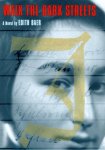 Walk the Dark Streets : A Novel by Edith Baer |
A girl's escape from Nazi Germany.
The city Eva Bentheim once adored is no longer familiar. A swastika is emblazoned on the flag
atop the City Hall. Teachers, family, and friends are beginning to disappear. Her father seems
gone in a different way; he has become ill, fragile, and despondent as the Nazis gain power.
When things get worse, Eva's mother desperately tries to obtain the proper papers for her
family to leave the country. Then a horrible night of roundups occurs and Eva's father is taken
away. A nocturnal search begins for someone who can help release him from the city jail. Eva's
boyfriend, Arno, may have a way to save her father from deportation, but it soon becomes clear
that their struggles have just begun. Exquisitely felt and written, Walk the Dark Streets resonates
with the indomitability of the human spirit even as a loving family's attempts to stay together grow
more and more hopeless.
With this haunting, painful sequel to her elegiac autobiographical novel A Frost in the Night, Baer ushers her heroine, the German-Jewish girl Eva Bentheim, through the rise of the Reich, from l933 to l940. Eva's age is not given; even as she is a distinct, lifelike character, she represents an innocence lost to her elders and to her country. As the novel begins, she emerges from a lengthy illness at the same time that Germany succumbs to Hitler. The climate steadily darkens: first some of her classmates show up in Hitler Youth uniforms; Social Democrat and Catholic teachers are fired; a friend's father, a journalist, is severely beaten. Restrictions multiply, but are lifted just as the l936 Olympics invite the world's attention. Friends and relatives make plans to leave, at increasingly desperate costs (one of Eva's aunts, for example, marries a virtual stranger, because he is Dutch and can offer her a home in Holland). Eva's father can see what lies in store, but he is too ill to escape - although he is offered sponsorship by an American citizen, he knows he will fail the physical at the consulate, and he and Eva's mother decide that Eva must leave by herself. Baer shows how the network of fear slowly tightens - how apparently innocent acts, like walking down the street with a long-time friend, can suddenly become fatally dangerous. Readers who know the history will find the tension almost unbearable, especially in such passages as those describing the days before Kristallnacht. But virtually no reader will be able to turn away from this implacably paced, resoundingly authentic study in tragedy. |
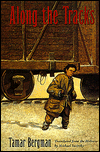 Along the Tracks by Tamar Bergman |
The author of The
Boy from Over There (1988) bases this story about a boy in the USSR during
WW II on the real experiences of a Polish family that later emigrated to Palestine. Told in the third
person from various points of view, the novel's first section describes Rosa and Yitzhak's desperate
flight from Lodz with their two children as the Nazis seal off the ghetto. They find a haven in the
Crimea until Hitler invades Russia; then Yitzhak joins the Russian army while Rosa and the children
again escape east. In the confusion of an air attack, Yankele, now eight, falls from their train and is
lost. During the next four years--as narrated by Yankele, now prudently known as Yasha--the boy
survives by stealing food, making fleeting alliances with other lost boys, snuggling into the "Black
Hotel'' (still-smoldering cinders piled by the railroads), and hopping trains whenever local merchants
begin to recognize him. Against all hope, the family is reunited at the war's end. Yankele's experiences
transform him from a trusting, dependent eight-year-old into a wily, self-reliant urchin who maintains
an inner core of innocence even though he finds it difficult, once it's no longer necessary, to break the
habit of thieving. Meanwhile, readers are exposed to a compellingly authentic picture of life in the likes
of Tashkent and Samarkand during the war--a cruel world where the state effectively abandoned
homeless children, but where some remnants of kindness and humanity survived. A gripping, evocative
story; the translation is excellent.
|
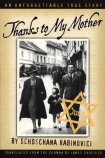 Thanks to My Mother By Schoschana Rabinovici |
Susie Weksler was only eight in 1941 when Hitler's forces
invaded her Lithuanian city of Vilnius, a great center for Jewish
learning and culture. Soon her family would face hunger and
fear in the Jewish ghetto - but worse was to come. When the
ghetto was liquidated, some Jews were selected for forced
labor camps; the rest were killed. Susie would live - because
of the courage and ingenuity of her mother. It was her mother
who carried Susie, hidden in a backpack, to the group destined
for the labor camps; who disguised her as an adult in makeup
and turban to fool the camp guards; who fed her body and
soul through gruesome conditions in three concentration camps
and a winter "death march"; who showed her the power of the
human spirit to endure.
Autobiography (NOT fiction) |
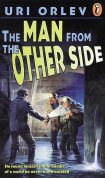 The Man from the Other Side By Uri Orlev |
When Israeli author Orlev, who drew on his own ghetto experiences in
The
Island on Bird Street, met a certain Polish journalist, they found that both
had been boys in Warsaw during WW II; Orlev kept "Marek's" extensive confidences
secret (including his discovery in 1942 that his father--executed in 1934 as a
Communist--was Jewish) until his death in 1987. Now, Orlev shapes Marek's account
into a powerful novel about a devout 13-year-old Catholic in a virulently
anti-Semitic society, responding to his experiences by coming to champion the
Jews walled in near his home. With stepfather Antony, Marek already knows the
ghetto: traveling through sewers, they take food to sell there at high prices,
often returning with a baby to hide with the nuns (no charge). Still, Marek is
casually anti-Semitic until he helps rob a Jewish escapee and is caught by his
mother, who points out that "You sentenced him to death" and reveals his own
heritage. Deeply shaken, Marek sets out to make amends. He befriends a man he
sees crossing himself the wrong way and ultimately leads him back, underground,
to the ghetto, during the heroic ghetto uprising. Orlev's characters are
sobering, believable blends: e.g., Antony dislikes Jews but, knowing Marek's
background, wants to adopt him; he turns others' dire needs to profit but has
"nothing against human beings." Many others in this richly authentic story
are equally complex. Subtle, beautifully crafted, altogether compelling.
Based on a true story of a Polish boy living in Nazi-occupied Warsaw just before the 1943 uprising, this understated but very revealing fictional memoir follows 14-year-old Marek through some harrowing experiences as he is drawn into this Jewish battle for survival--on both sides of the Ghetto wall. Until his Catholic mother informs Marek that his father was a Jew and had been killed in prison because he was a Communist, the boy has extremely negative feelings about Jews. When he helps Jozek, a Polish Jew hiding from the Nazis and anti-Semitic Poles in Warsaw, he begins a series of events that ultimately results in Jozek's violent death at the hands of the Nazis and Marek's narrow escape from the beseiged quarter. Characterizations are vivid and finely drawn, even those of minor figures such as Marek's empathetic mother who is embarrassed by her countrymen's hatred of Jews; his crude, contradictory stepfather; and his grandparents, who treat Jozek as a family member, all the while hating Jews. This is a story of individual bravery and national shame that highlights just how hopeless was the fate of the Warsaw Jews as they fought alone and heroically against the Nazi war machine. A true story of WW II Warsaw, this novel relates events so dramatic as to be cataclysmic. But the voice of its 14-year-old narrator, Marek, would be gripping given any plot, so candid that it tolerates admissions of less-than-exemplary behavior as well as a more-than-exemplary atonement. A Pole, Marek helps his stepfather smuggle goods into the Jewish ghetto, enduring trips through the foul sewers not from altruism but in order to reap lucrative profits. When two streetwise buddies decide to mug a runaway Jew, he helps: "They will `shave' some Jew anyway, so what difference does it make if I join them?" he tells himself. But Marek's mother finds his share of the loot and, appalled, explains that he has consigned his victim to certain death, then reveals that Marek's long-dead father was born Jewish. Marek, who has imbibed much of the local anti-Semitism, decides to use the money to help another Jew, and his actions lead him into the ghetto during the peak of the uprising. A survivor of that ghetto, Orlev neither demonizes nor glorifies, whether portraying Poles or Jews, fighters or collaborators. His refusal to exaggerate gives the story unimpeachable impact. |
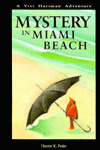 Mystery in Miami Beach : A Vivi Hartman Mystery By Harriet K. Feder |
Vivi Hartman, a rabbi's daughter, visits her grandmother in Florida during her
winter break. While on the plane, she reads a front-page Miami Herald story
about an Israeli tourist attacked by a gang. The woman is her grandmother's
friend, also visiting in Gram's apartment. In quick succession, Vivi meets a teenaged
boy and begins to notice that a rash of red birds, umbrellas, tall men with British
accents, and other suspicious characters seem to be popping up everywhere. This
is a fast-paced mystery, the premise of which is rooted during the Holocaust --
specifically with the ship St. Louis, which was not allowed to land in either Cuba
or Miami in 1939. The ship returned to Europe, where most of the 907 Jewish
passengers died. Hebrew terms and Jewish customs are woven seamlessly into
the story; indeed, much of this information is crucial to the plot, and all of it adds
depth. If Vivi remembers to utilize pilpul -- rabbinical logic -- to solve the ensuing
mysteries, she could be a modern-day Sherlock Holmes who also happens to be
a nice, bright American Jewish girl.
|
 When the Soldiers Were Gone By Vera W. Propp |
An account of a boy's readjustment after World War II in Holland. Eight-year-old
Henk is stunned when he discovers that the family he has been living with are not his
blood relatives. After being reunited with his biological parents, who are Jewish,
Henk learns that his name is really Benjamin Van Sorg and that he was sent to
live with a Christian family during the war. As he slowly adjusts to his new life
and identity, memories from his early childhood gradually return, including the
yellow star on his coat and a frightening encounter with a Nazi soldier. At the end
of the book, when he and his parents return to their house, the place seems
familiar and welcoming, and he finally feels that he is home. Propp's use of simple
language helps the story flow smoothly. The author creates and sustains a mood
that coincides with the readjustment phase that takes place after a trauma.
Historical facts are successfully integrated into the narrative, and Henk's
first-person telling makes the effects of the war tangible to readers. When
the Soldiers Were Gone rates highly among other stories about the period.
|
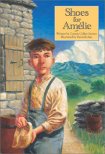 Shoes for Amelie By Connie Colker Steiner |
Awards:
Every week strangers come to Lucien's farm in the French countryside only to leave in secrecy a few days later. From the whispering of people around him, Lucien learns there is a war on and that Jews are in trouble.
Shoes for Amélie is a heartwarming story of friendship and loyalty, as well as a sensitive introduction to the tragedy of the second world war. The story is based on a real "Lucien" who helped his family hide Jews from their persecutors in France. Shoes for Amélie includes a historical note, black, and white photographs of the real "Lucien." Lucien has a new friend. Her name is Amelie. Like the many people before her and her family, Amelie's coming to Lucien's family farm is a secret. In the days they are together, Lucien learns that Amelie has never been on a farm. Their friendship grows and as time goes by, Lucien notices that the beautiful shoes Amelie was wearing when she arrived are now worn out. Lucien decides to make this special friend a pair of shoes like his. While this friendship grows so do the many questions Lucien has about these mysterious visitors. Many excellent children's books have been written about the Holocaust. Such books describe the pain and anguish that the Jewish people of Germany, Poland, and many other countries suffered at the hands of their tormentors. Connie Colker Steiner's book is one of these works. While it is a short and easy book, it conveys not only the Jewish experience but also the experience of those who helped the Jews hide from persecution, and in a way that young readers can understand. |
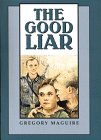 The Good Liar by Gregory Maguire |
Hoping for a good grade on their World War II project, three Florida girls write a letter of questions to Marcel Delarue, an artist who grew up in occupied France. In reply, he sends a long letter that becomes the text of this first-person novel. After he sketches in the background (a village in the middle of France), and the central characters (Marcel, his two brothers, and their mother), their story begins to unfold. The framework of the letters gradually disappears from readers' consciousness as Marcel's childhood observations and experiences become increasingly compelling. The three brothers are convincingly imperfect in their actions, childlike in their attitudes, and human in their reactions to events and emotions. Marcel's innocent, often silly lies and escapades are eventually shadowed by the realization of certain misunderstood conversations and events that add up to a larger lie. Marcel's mother finally lets him in on the secret to keep him from unwittingly revealing it: for more than a year, a Jewish woman and her daughter have been hiding in a secret crawl space in their home, coming out only at night when the children are asleep. Quietly told, this absorbing story carries the conviction of memoir rather than invention. Another memorable story of World War II.
Maguire frames a story of life in occupied France during WWII within a contemporary letter that changes the lives of both the writer and the recipients. Marcel and his two older brothers, Ren and Pierre, live a simple life in their small French village. They fish, play war games, and tell imaginative lies to add zest to the days. When Ren and Marcel strike up a friendship with a German soldier during the summer of 1942, they unwittingly imperil their family; their mother has been hiding in her home a Jewish woman and her daughter for a year while pretending that the two had been taken away by the Nazis. The boys, so proud of their abilities to tell lies, find out that their mother is the best liar of all. The clever frame allows Marcel to reminisce in context; his narrative is engrossing from the start. Maguire paints Marcel's confusing, childlike feelings with immediacy, and the atmospheric prose expertly juxtaposes the idylls of boyhood with the dark reality of WWII. In fact, in the end the letter-writer determines that his life was not as golden as he had imagined. Humorous, sad, involving vignettes comprise the short, fast-paced chapters that add up to a tale that seems more vivid memoir than invented. |
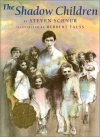 The Shadow Children By Steven Schnur |
After World War II, 11-year-old Etienne revisits his beloved grandfather's farm near the village of Mont Brulant. But this year, Grand-pere's town seems different. Etienne wonders why there aren't any children, but no one will tell him. Then one day Etienne discovers the secret of the shadow children of Mont Brulant—and the unspeakable tragedy that took them away.
Etienne, a French boy, notices groups of ragged children near his grandfather's farm. Grand-pére insists that the boy is imagining things; later, he reluctantly reveals a dark secret. During the war, the villagers had sheltered hundreds of Jewish children, but when the Nazis came, the townspeople were fearful for their own safety and only stood and watched as the children were taken away. The ghosts of these children have haunted the village ever since. A thought-provoking story of unredeemed guilt, ideal for class discussions. Etienne, 11, looks forward to his summer at Grand-pere's farm near Mont Brulant. This year, though, things are different, for he sees ragged refugee children no one else notices and discovers artifacts in the woods where railroad tracks used to run. He meets Isaac, the children's teacher, and hears the whistle of a nonexistent train. Slowly, Etienne realizes he is reliving events that occurred years before, during World War II, when the Jewish children in the town were turned over to the Nazis. Schnur's novel is poignant and haunting. Etienne's direct, first-person narrative draws readers into his world, one of pleasure and puzzlement, action and reflection. The fantasy elements are smoothly integrated into the story, and add a unique slant to a frequently covered topic. A thought-provoking addition to the World War II literature. |
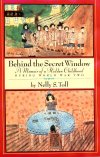 Behind the Secret Window: A Memoir of a Hidden Childhood During World War Two By Nellie S. Toll |
For thirteen months during World War II, Nelly Toll and her mother were hidden from the Nazis in the small bedroom of a Gentile couple in Lwow, Poland. Just eight years old when she went into hiding in 1943, Nelly began keeping the diary that would inspire this powerful and moving memoir of her childhood. In her small black journal Nelly wrote about the heartbreaking events she experienced in Lwow and her grief over the tragic losses of family members, as well as the day-to-day fears of life in hiding. In contrast, the exuberant, vividly colored paintings that Nelly also produced while in hiding transformed her grim reality into an enchanting fantasy world filled with school friends, bright skies, and happy families. Twenty-nine of these paintings are reproduced in Behind the Secret Window; captions help readers to trace the fascinating process of their creation. Together, text and art tell the story of a lovable, imaginative child beset with terrifying uncertainties, and of the courageous mother who nurtured her daughter's unswerving belief in brighter days ahead.
In Toll's remembrance, art equals hope: her happy family pictures, painted in the secret room where she and her mother hid from the Nazis and the Poles, show extraordinary preteen talent (some of the 29 powerfully evocative paintings reproduced here now hang in Yad Vashem, the Holocaust memorial in Israel) as well as the will to survive. Nelly's plight--going from bonbons served on silver platters to hiding behind false walls--was not atypical. In some ways reminiscent of Maus, this emotionally complex and informative memoir reports the willingness of some neighbors to turn in Jews for a bag of potatoes and a bottle of vodka. Adults are keenly observed: a tutor nearly becomes a sex offender; the paranoid man who hides Nelly is both horrifying (wife-beating) and funny (he parades through town with a stack of hats on his head, … la Caps for Sale). The poignancy is heightened by evocative language ("minutes walked by with small steps") and raw emotional hunger ("waiting, waiting for Papa"), and by the postwar rush to reconstitute families by swift remarriages--not seen in many Holocaust books, but an important aspect of healing (Ruth Minsky Sender's To Life). Toll was only six years old when the Nazis marched into her native Lwow (Poland) in 1941. Although her childhood had been shattered two years earlier by the advent of the Russian Army, she and her family were to undergo the full depredations of the Nazis' anti-Semitism. In a remarkably even yet childlike tone, Toll describes persecution by neighbors and former servants as well as the Germans, and we watch as her world shrinks, from an affluent home to cramped quarters in a ghetto to a tiny, hidden room in the Gentile part of town. With her mother, Toll spent more than a year in hiding, dependent on the goodwill of their mercurial Polish patrons, who more than once lost their courage and almost evicted the refugees. While her mother fended off the unwanted attentions of their host and while everyone dodged the suspicions of neighbors, Toll wrote stories and painted pictures, conjuring for herself the pleasures of a normal childhood. Twenty-nine of her watercolors are included here; their poignancy is matched only by the art in I Never Saw Another Butterfly. Without emphasizing horror and loss, Toll conveys the effects of human evil and human folly, summoning up the forces of tragedy and courage. Toll's harrowing account of her family's experiences during and immediately following World War II joins a growing body of Holocaust literature for young adults. Toll was born into a wealthy Jewish family in Lwow, Poland, and her narrative begins in June_ 1941, when the Germans ousted the Russians from her town. To escape transportation to Siberia, her father had been in hiding since 1939. When the Germans began imposing sanctions on the Jews and herding them into a ghetto, he began making plans to hide his family. After her four-year-old brother was taken away in a raid on the ghetto, Toll and her mother joined a group trying to reach Hungary. Victimized by the Germans, they barely escaped a massacre. In 1943, a Christian couple agreed to hide them, and Toll, with her mother, began a nightmarish stay in a hidden room, uncertain of the fate of her father. Toll writes of her experiences in an emotionally controlled, thoughtful manner that only serves to emphasize the horrors she experienced. She relies extensively on a diary she began when she entered hiding at the age of eight, and her story is illustrated with full-color paintings she made during the same period. A fine addition to all school and library collections, this will be especially valuable where Holocaust studies are mandated. |
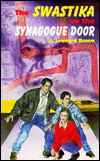 The Swastika on the Synagogue Door By J. Leonard Romm |
When a Long Island synagogue is defaced with a swastika and an anti-semitic slogan, a teenage brother and sister try to solve the mystery with the help of their rabbi and a Holocaust survivor.
|
Biblical Era |
Middle Ages & Renaissance |
Immigration & The American Experience |
European History |
Holocaust
(Page 1)
(Page 2)
(Page 3)
(Page 4)
(Page 5)
(Page 6) |
Israel
Still can't find what you're looking for? Search Amazon.com's database directly.
©1999-2009
(NOTE: The following links have NOT been placed on the site by the website owners. We have no control over which ads are selected and are not responsible for their religious content.)
Still can't find what you're looking for? Search Amazon.com's database directly.